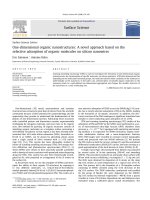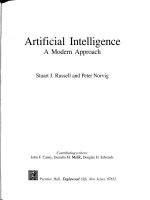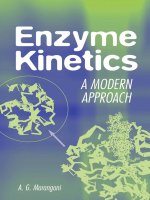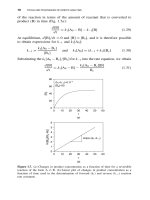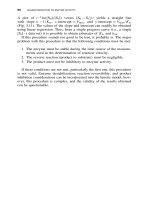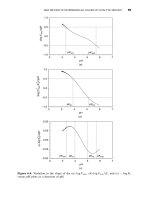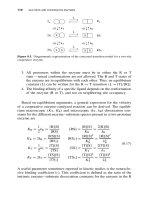Organic chemistry a modern approach 1
Bạn đang xem bản rút gọn của tài liệu. Xem và tải ngay bản đầy đủ của tài liệu tại đây (44.81 MB, 875 trang )
www.pdfgrip.com
ORGANIC CHEMISTRY
A Modern Approach
Volume-I
www.pdfgrip.com
ABOUT THE AUTHOR
Nimai Tewari is a retired associate Professor, Department of Chemistry,
Katwa College (affiliated to The University of Burdwan), West Bengal.
A PhD in Organic Chemistry from Calcutta University, he has taught
the subject for a period of more than three decades. He has published
various research papers in national and international journals.
Apart from Organic Chemistry—A Modern Approach, Dr Tewari has
authored three more books on Organic Chemistry for undergraduate
and postgraduate students. His research interest includes Organic
Synthesis and Heterocyclic Chemistry.
www.pdfgrip.com
ORGANIC CHEMISTRY
A Modern Approach
Volume-I
Nimai Tewari
Associate Professor (Retired)
Department of Chemistry
Katwa College
(affiliated to The University of Burdwan)
West Bengal
McGraw Hill Education (India) Private Limited
CHENNAI
McGraw Hill Education Offices
Chennai New York St Louis San Francisco Auckland Bogotá Caracas
Kuala Lumpur Lisbon London Madrid Mexico City Milan Montreal
San Juan Santiago Singapore Sydney Tokyo Toronto
www.pdfgrip.com
McGraw Hill Education (India) Private Limited
Published by McGraw Hill Education (India) Private Limited
444/1, Sri Ekambara Naicker Industrial Estate, Alapakkam, Porur, Chennai 600 116
Organic Chemistry—A Modern Approach (Volume-I)
Copyright © 2017, by McGraw Hill Education (India) Private Limited.
No part of this publication may be reproduced or distributed in any form or by any means, electronic, mechanical,
photocopying, recording, or otherwise or stored in a database or retrieval system without the prior written permission
of the publishers. The program listings (if any) may be entered, stored and executed in a computer system, but they
may not be reproduced for publication.
This edition can be exported from India only by the publishers,
McGraw Hill Education (India) Private Limited.
ISBN (13): 978-93-5260-565-1
ISBN (10): 93-5260-565-9
Managing Director: Kaushik Bellani
Director—Science & Engineering Portfolio: Vibha Mahajan
Lead—UG Portfolio: Suman Sen
Content Development Lead: Shalini Jha
Specialist—Product Development: Amit Chatterjee
Production Head: Satinder S Baveja
Sr. Manager—Production: Piyaray Pandita
General Manager—Production: Rajender P Ghansela
Manager—Production: Reji Kumar
Information contained in this work has been obtained by McGraw Hill Education (India), from sources believed to be
reliable. However, neither McGraw Hill Education (India) nor its authors guarantee the accuracy or completeness of any
information published herein, and neither McGraw Hill Education (India) nor its authors shall be responsible for any
errors, omissions, or damages arising out of use of this information. This work is published with the understanding that
McGraw Hill Education (India) and its authors are supplying information but are not attempting to render engineering or
other professional services. If such services are required, the assistance of an appropriate professional should be sought.
Typeset at Text-o-Graphics, B-1/56, Aravali Apartment, Sector-34, Noida 201 301, and printed at
Cover Printer:
Visit us at: www.mheducation.co.in
www.pdfgrip.com
Dedicated to
my daughter Aindrila
and
my son-in-law Ritam Mukherjee
whose forbearance, constant
encouragement and inspiration
made this work possible
www.pdfgrip.com
www.pdfgrip.com
CONTENTS
Preface
1.
Structure, Bonding and Properties of Organic Molecules
1.1
xv
1.1–1.313
Hybridization, Bond Lengths, Bond Strengths or Bond Dissociation
Enthalpies, Bond Angles and VSEPR Theory 1.2
1.1.1 Hybridization 1.2
1.1.2 Bond Length 1.9
1.1.3 Bond Dissociation Enthalpy or Bond Dissociation Energy 1.9
1.1.4 Bond Angle 1.10
1.1.5 VESPR Theory and Molecular Geometry 1.11
Solved Problems 1.13
Study Problems 1.21
1.2 Electronegativity and Bond Polarity 1.22
Solved Problems 1.33
Study Problems 1.42
1.3 Molecular Formula as a Clue to Structure: Double Bond Equivalent (DBE) or
Index of Hydrogen Deficiency (IHD) 1.44
Solved Problems 1.44
Study Problems 1.46
1.4 Acids and Bases 1.46
1.4.1 Brönsted-Lowry Theory of Acids and Bases 1.46
1.4.2 Lewis Acid-Base Theory 1.52
Solved Problems 1.53
Study Problems 1.57
1.5 Inductive and Electrometric Effects 1.60
1.5.1 Inductive Effect 1.60
1.5.2 Field Effect 1.67
1.5.3 Electromeric Effect 1.67
Solved Problems 1.67
Study Problems 1.73
www.pdfgrip.com
Contents
viii
1.6 Resonance and Resonance Effect or Mesomeric Effect 1.75
1.6.1 Resonance Energy 1.77
1.6.2 Rules for Writing Meaningful Resonance Structures 1.78
1.6.3 Relative Contribution of Resonance Structures towards Resonance
Hybrid 1.78
1.6.4 Resonance or Mesomeric Effect 1.80
1.6.5 Isovalent and Heterovalent Resonance 1.81
1.6.6 Effect of Resonance on the Properties of Molecules 1.81
Solved Problems 1.98
Study Problems 1.112
1.7 Hyperconjugation 1.117
1.7.1 Sacrificial and Isovalent Hyperconjugation 1.119
1.7.2 Effect of Hyperconjugation on the Physical and Chemical Properties of
Molecules and on the Stabilities of Intermediates 1.119
Solved Problems 1.122
Study Problems 1.124
1.8 Steric Effect 1.125
1.8.1 Properties of Molecules Influenced by Steric Effect 1.126
1.8.2 Proton Sponges 1.132
1.8.3 Face Strain or F-Strain 1.133
1.8.4 Steric Acceleration and Steric Retardation 1.134
1.8.5 Bredt’s Rule 1.135
Solved Problems 1.138
Study Problems 1.142
1.9 Intermolecular Forces 1.147
1.9.1 Dipole–Dipole Interactions 1.147
1.9.2 van der Waals Forces 1.149
1.9.3 Effect of Intermolecular Forces on Different Properties of
Compounds 1.150
Solved Problems 1.161
Study Problems 1.167
1.10 Reactive Intermediates 1.170
1.10.1 Nonclassical Carbocation 1.177
1.10.2 Carbonium Ion and Carbenium Ion or Carbocation 1.178
Solved Problems 1.193
Study Problems 1.212
1.11
Tautomerism 1.218
1.11.1 Mechanism of Keto-enol Tautomerism 1.221
1.11.2 Difference between Resonance and Tautomerism 1.222
1.11.3 Position of the Tautomeric Equilibrium 1.223
1.11.4 Ring-chain Tautomerism 1.228
1.11.5 Valence Tautomerism 1.228
Solved Problems 1.228
Study Problems 1.236
www.pdfgrip.com
Contents
ix
1.12 Aromaticity 1.240
1.12.1 Criteria for Aromaticity 1.240
1.12.2 Antiaromatic Compounds 1.242
1.12.3 Nonaromatic Compounds 1.242
1.12.4 Classification of Compounds as Aromatic, Antiaromatic and Nonaromatic
by Comparing their Stabilities with that of the Corresponding Open Chain
Compounds 1.243
1.12.5 Modern Definition of Aromaticity 1.243
1.12.6 Molecular Orbital Energy Diagram of Some Ions and Molecules 1.244
1.12.7 Use of Inscribed Polygon Method to Determine the Relative Energies
of p Molecular Orbitals for Cyclic Planar and Completely Conjugated
Compounds and to Classify Them as Aromatic and Antiaromatic 1.245
1.12.8 Classification of Some Molecules and Ions as Aromatic, Antiaromatic and
Nonaromatic 1.247
1.12.9 Homoaromatic Compounds 1.251
1.12.10 Some Chemical and Physical Consequences of Aromaticity 1.251
Solved Problems 1.262
Study Problems 1.267
1.13 Thermodynamics, Energy Diagrams and Kinetics of Organic Reactions 1.276
1.13.1 Thermodynamics 1.276
1.13.2 Energy Diagram 1.278
1.13.3 Kinetics 1.281
1.13.4 Catalysis 1.283
1.13.5 Hammond Postulate 1.284
1.13.6 Kinetic Control versus Thermodynamic Control of a Chemical Reaction 1.286
Solved Problems 1.287
Study Problems 1.295
1.14 Methods of Determining Mechanisms of Reactions 1.298
1.14.1 Kinetic Isotope Effects 1.305
Solved Problems 1.307
Study Problems 1.312
2.
Principles of Stereochemistry
Introduction
2.1
2.2
2.1–2.230
2.2
Projection Formulas of Stereoisomers 2.3
2.1.1 Flying-Wedge Projection Formula 2.3
2.1.2 Fischer Projection Formula 2.4
2.1.3 Sawhorse Projection Formula 2.10
2.1.4 Newman Projection Formula 2.11
2.1.5 Interconversion of Projection Formulas 2.12
Solved Problems 2.16
Study Problems 2.25
Symmetry Elements 2.29
2.2.1 Simple Axis of Symmetry or Rotational Axis of Symmetry (Cn) 2.29
2.2.2 Plane of Symmetry (s) 2.33
www.pdfgrip.com
Contents
x
2.3
2.4
2.5
2.6
2.2.3 Centre of Symmetry (i) 2.36
2.2.4 Alternating Axis of Symmetry (Sn) 2.37
2.2.5 Symmetric, Asymmetric and Dissymmetric Molecules 2.38
Solved Problems 2.39
Study Problems 2.56
Isomerism: Constitutional Isomers and Stereoisomers 2.58
2.3.1 Constitutional Isomers 2.58
2.3.2 Stereoisomers 2.59
2.3.3 Enantiomers and Diastereoisomers 2.59
Solved Problems 2.64
Study Problems 2.79
Molecular Chirality 2.84
2.4.1 Chiral and Achiral Molecules 2.84
2.4.2 Source of Chirality 2.85
2.4.3 Stereocentre or Stereogenic Centre 2.88
2.4.4 Meso Compounds 2.89
Solved Problems 2.91
Study Problems 2.104
Configuration and Configurational Nomenclature 2.108
2.5.1 D, L-System of Configurational Designation 2.109
2.5.2 Specification of Configuration: The R, S-System 2.111
2.5.3 Erythro and Threo Nomenclature of Compounds with Two Adjacent Chiral
Centres 2.124
2.5.4 The E-Z System of Designating Alkene Diastereoisomers 2.125
2.5.5 R, S and E, Z Assignment in the Same Molecule (Geometric
Enantiomerism) 2.127
2.5.6 Syn-anti Nomenclature for Aldols 2.128
2.5.7 Number of Stereoisomers for Compounds with Chiral Centres 2.129
2.5.8 Chirotopic and Achirotopic Atom in a Molecule 2.131
2.5.9 Prostereoisomerism and Topicity 2.133
Solved Problems 2.141
Study Problems 2.175
Optical Activity of Chiral Compounds 2.182
2.6.1 Plane-polarized Light 2.182
2.6.2 Optical Activity 2.182
2.6.3 Polarimeter 2.183
2.6.4 Specific Rotation 2.184
2.6.5 The Necessary and Sufficient Condition (the ultimate criterion) for Optical
Activity 2.186
2.6.6 Racemic Modification 2.187
2.6.7 Enantiomeric Excess (EE) or Optical Purity (EE) 2.187
2.6.8 Racemization 2.188
2.6.9 Resolution of Racemic Modification 2.192
Solved Problems 2.199
Study Problems 2.208
www.pdfgrip.com
Contents
xi
2.7 Conformation of Acyclic Organic Molecules 2.211
2.7.1 Conformations of Ethane (CH3—CH3) 2.213
2.7.2 Conformations of Propane (CH3CH2CH3) 2.214
2.7.3 Conformations of Butane (CH3CH2CH2CH3) 2.215
2.7.4 Conformations of Chloroethane (CH3CH2Cl) 2.218
2.7.5 Conformations of 1,2-dichloroethane (ClCH2CH2Cl) 2.218
2.7.6 Conformations of Some Typical Acyclic Molecules 2.219
2.7.7 Invertomerism 2.220
Solved Problems 2.221
Study Problems 2.227
3.
Nucleophilic Substitution Reactions at Saturated Carbon Atom
3.1–3.180
Introduction 3.2
3.1 The SN2 reaction 3.3
3.1.1 Example of SN2 Reaction 3.3
3.1.2 Kinetics of SN2 Reaction 3.3
3.1.3 Mechanism of SN2 Reaction 3.3
3.1.4 Stereochemistry of SN2 Reaction 3.5
3.1.5 Evidence in Favour of SN2 Mechanism 3.6
3.1.6 Factors Influencing SN2 Reaction Rate or SN2 Reactivity 3.7
Solved Problems 3.35
Study Problems 3.74
3.2 The SN1 Reaction 3.86
3.2.1 Example of SN1 Reaction 3.86
3.2.2 Kinetics of SN1 Reaction 3.86
3.2.3 Mechanism of SN1 Reaction 3.86
3.2.4 Stereochemistry of SN1 Reaction 3.87
3.2.5 Evidence in Favour of SN1 Mechanism 3.90
3.2.6 Factors Influencing SN1 Reaction Rate or SN1 Reactivity 3.91
3.2.7 Carbocation Rearrangements in SN1 Reactions 3.105
3.2.8 Comparison of the SN2 and SN1 Reactions 3.108
3.2.9 Summary of Reactivity of Alkyl Halide in Necleophilic Substitution
Reactions 3.108
3.2.10 Factors Favouring SN1 and SN2 Reactions 3.108
3.2.11 SNi and SNi¢ Mechanisms 3.109
3.2.12 SN1¢ Mechanism 3.112
3.2.13 Isotope Effects and Salt Effects (Methods used to Distinguish between SN1
and SN2 Type Reactions) 3.113
Solved Problems 3.114
Study Problems 3.135
3.3 Neighbouring Group Participation (NGP) 3.146
3.3.1 Definition 3.146
3.3.2 Mechanism of NGP 3.146
3.3.3 Example of NGP 3.146
3.3.4 Anchimeric Assistance 3.147
www.pdfgrip.com
Contents
xii
3.3.5 Evidence for Participation by a Neighbouring Group 3.148
3.3.6 Various Cases of Neighbouring Group Participation 3.148
Solved Problems 3.163
Study Problems 3.175
4.
Elimination Reactions
4.1–4.128
Introduction 4.2
4.1 The E2 Reaction 4.4
4.1.1 Example of E2 Reaction 4.4
4.1.2 Kinetics of E2 Reaction 4.4
4.1.3 Mechanism of E2 Reaction 4.4
4.1.4 Stereochemistry of E2 Reaction 4.5
4.1.5 Evidence in Favour of the E2 Mechanism 4.32
4.1.6 Factors Influencing E2 Reaction Rate or E2 Reactivity 4.33
4.1.7 Factors that Govern the Proportions of E2 and SN2 Reactions 4.34
4.1.8 Regioselectivity in b-elimination Reactions (Orientation of p Bond in the
Product Alkene) 4.37
4.1.9 Hofmann Exhaustive Methylation or Hofmann Degradation 4.43
4.1.10 Fragmentations 4.45
4.1.11 Summary of the E2 Reaction 4.47
Solved Problems 4.47
Study Problems 4.74
4.2 The E1 Reaction 4.86
4.2.1 Example of E1 Reaction 4.86
4.2.2 Kinetics of E1 Reaction 4.87
4.2.3 Mechanism of E1 Reaction 4.87
4.2.4 Stereochemistry of E1 Reaction 4.88
4.2.5 Evidence in Favour of the E1 Mechanism 4.90
4.2.6 Factors Influencing E1 Reaction Rate or E1 Reactivity 4.90
4.2.7 Regioselectivity of E1 Reactions 4.90
4.2.8 Rearrangement of the Carbocation Intermediate Involved in an E1
Reaction 4.93
4.2.9 Acid-Catalyzed Dehydration of Alcohols 4.95
4.2.10 Dehydration using POCl3 and Pyridine 4.99
4.2.11 Factors Influencing the Extent of E1 and E2 Reactions 4.100
4.2.12 Factors that Govern the Proportions of E1 and SN1 Reactions 4.101
Solved Problems 4.102
Study Problems 4.114
4.3 The E1CB Reaction 4.118
4.3.1 Example of E1cB Reaction 4.118
4.3.2 Kinetics of E1cB Reaction 4.118
4.3.3 Mechanism of E1cB Reaction 4.118
4.3.4 The Nature of the Substrate 4.119
www.pdfgrip.com
Contents
xiii
4.3.5 To Distinguish between E1cB and E2 Mechanisms 4.119
Solved Problems 4.121
Study Problems 4.125
4.4 a- or 1,1-Elimination 4.126
4.4.1 Example of a- or 1,1-Elimination Reaction 4.126
4.4.2 Kinetics of a- or 1,1-Elimination Reaction 4.126
4.4.3 Mechanism of a- or 1,1-Elimination Reaction 4.126
4.4.4 Structure of the Substrate Involved in a-Elimination 4.127
Solved Problems 4.127
Study Problems 4.128
Index
I.1–I.6
www.pdfgrip.com
www.pdfgrip.com
PREFACE
In the course of teaching Organic Chemistry to undergraduate students, I have been
constantly feeling the need of a concise volume that deals with their important topics on
the subject matter. Students have often expressed their difficulty caused by the absence of
such a compact book. My present effort is to meet this long-felt need and the book has been
designed primarily for the students who have taken a basic course in Organic Chemistry
at the undergraduate level.
The book covers some important topics on Organic Chemistry in four chapters. It starts
with a chapter on Structure, Bonding and Properties of Organic Molecules, highlighting
concepts like hybridization, electronegativity and bond polarity, acids and bases, inductive
effect, resonance, steric effect, intermolecular forces, etc.
Stereochemistry is an essential part of the organic chemistry courses. Chapter 2 deals with
the Principles of Stereochemistry. Chapter 3 covers Nucleophilic Substitution Reactions
at Saturated Carbon Atom and Chapter 4 covers the Elimination Reactions.
By following a modern methodology of learning, the book presents a large number of
reactions with discussions supported with mechanistic explanations and diagrams,
wherever needed. Organic chemistry is best learned by solving problems. Each article of
every chapter concludes with a number of Solved as well as Study Problems to provide an
opportunity to the students for self-evaluation.
I believe that this book will be of great utility for the students who have taken a basic
course of Organic Chemistry in B.Sc. (Chemistry) Hons., besides being equally effective
for advance students of Chemistry because of the in-depth discussion in a readerfriendly language. The book will also be useful for the students preparing for competitive
examinations like NET, SLET, etc.
Acknowledgements
I offer my sincere gratitude to Mr. Kaushik Bellani, MD, McGraw Hill Education (India)
Pvt. Ltd. and Mrs. Vibha Mahajan, Director, Science & Engineering Portfolio for successful
www.pdfgrip.com
xvi
Preface
publication of this book. I also wish to thank Mr. Sumen Sen, Mr. Amit Chatterjee and
Mr. P L Pandita for taking keen interest in publishing this book. I am grateful to all of
them.
I also owe a debt of gratitude to my colleagues for constructive suggestions and to my
students who encouraged me constantly. I appreciate the interest and enthusiasm shown
by my wife Mrs. Dali Tewari and my daughter Andrila Tewari (Mukherjee) during the
long period of preparation of the manuscript.
Valuable suggestions from the readers for the improvement of the book will be most
welcome.
Nimai Tewari
www.pdfgrip.com
1
CHAPTER
STRUCTURE, BONDING
AND PROPERTIES OF
ORGANIC MOLECULES
Chapter Outline
1.1
1.2
1.3
1.4
1.5
1.6
Hybridization, Bond Lengths, Bond
Strengths or Bond Dissociation
Enthalpies, Bond Angles and VSEPR
Theory
1.1.1 Hybridization
1.1.2 Bond Length
1.1.3 Bond Dissociation Enthalpy or
Bond Dissociation Energy
1.1.4 Bond Angle
1.1.5 VESPR Theory and Molecular
Geometry
Electronegativity and Bond Polarity
Molecular Formula as a clue to
structure: Double Bond Equivalent
(DBE) or Index of Hydrogen
Deficiency (IHD)
Acids and Bases
1.4.1 Brönsted-Lowry Theory of Acids
and Bases
1.4.2 Lewis Acid-Base Theory
Inductive and Electrometric Effects
1.5.1 Inductive Effect
1.5.2 Field Effect
1.5.3 Electromeric Effect
Resonance and Resonance Effect or
Mesomeric Effect
1.6.1 Resonance Energy
1.6.2 Rules for Writing Meaningful
Resonance Structures
1.6.3 Relative Contribution of Resonance
Structures towards Resonance
Hybrid
1.6.4 Resonance or Mesomeric Effect
1.6.5
1.7
1.8
1.9
1.10
1.11
Isovalent and Heterovalent
Resonance
1.6.6 Effect of Resonance on the
Properties of Molecules
Hyperconjugation
1.7.1 Sacrificial and Isovalent
Hyperconjugation
1.7.2 Effect of Hyperconjugation on the
Physical and Chemical Properties
of Molecules and on the Stabilities
of Intermediates
Steric Effect
1.8.1 Properties of Molecules Influenced
by Steric Effect
1.8.2 Proton Sponges
1.8.3 Face Strain or F-Strain
1.8.4 Steric Acceleration and Steric
Retardation
1.8.5 Bredt’s Rule
Intermolecular Forces
1.9.1 Dipole–Dipole Interactions
1.9.2 van der Waals Forces
1.9.3 Effect of Intermolecular Forces on
Different Properties of Compounds
Reactive Intermediates
1.10.1 Nonclassical Carbocation
1.10.2 Carbonium Ion and Carbenium Ion
or Carbocation
Tautomerism
1.11.1 Mechanism of Keto-enol
Tautomerism
1.11.2 Difference between Resonance and
Tautomerism
www.pdfgrip.com
1.2
1.12
1.1
Organic Chemistry—A Modern Approach
1.11.3 Position of the Tautomeric
Equilibrium
1.11.4 Ring-chain Tautomerism
1.11.5 Valence Tautomerism
Aromaticity
1.12.1 Criteria for Aromaticity
1.12.2 Antiaromatic Compounds
1.12.3 Nonaromatic Compounds
1.12.4 Classification of Compounds
as Aromatic, Antiaromatic and
Nonaromatic by Comparing
their Stabilities with that of
the Corresponding Open Chain
Compounds
1.12.5 Modern Definition of Aromaticity
1.12.6 Molecular Orbital Energy Diagram
of Some Ions and Molecules
1.12.7 Use of Inscribed Polygon Method to
Determine the Relative Energies
of p Molecular Orbitals for Cyclic
Planar and Completely Conjugated
1.13
1.14
Compounds and to Classify Them
as Aromatic and Antiaromatic
1.12.8 Classification of Some Molecules
and Ions as Aromatic, Antiaromatic
and Nonaromatic
1.12.9 Homoaromatic Compounds
1.12.10 Some Chemical and Physical
Consequences of Aromaticity
Thermodynamics, Energy Diagrams
and Kinetics of Organic Reactions
1.13.1 Thermodynamics
1.13.2 Energy Diagram
1.13.3 Kinetics
1.13.4 Catalysis
1.13.5 Hammond Postulate
1.13.6 Kinetic Control versus
Thermodynamic Control of a
Chemical Reaction
Methods of Determining Mechanisms
of Reactions
1.14.1 Kinetic Isotope Effects
HYBRIDIZATION, BOND LENGTHS, BOND STRENGTHS OR BOND
DISSOCIATION ENTHALPIES, BOND ANGLES AND VSEPR THEORY
1.1.1 Hybridization
The process of intermixing of atomic orbitals of the same atom having slightly different
energies so as to redistribute their energies and give new orbitals of equal energies and
identical shapes and sizes is called hybridization.
The number of hybrid orbitals is equal to the number of pure atomic orbitals reshuffled.
The hybrid orbitals are more effective in forming stable bonds as compared to the pure
atomic orbitals and this is because they can undergo more effective overlapping. The
relative overlap of orbitals decreases in the following order: sp > sp2 > sp3 >> p. The hybrid
orbitals are oriented in space in some preferred directions to have a stable arrangement in
which there is minimum repulsion among themselves. Therefore, the type of hybridization
governs the geometrical shapes of the molecules.
Hybrid orbitals
Hybridization
Geometry
Bond angle
2
3
4
s + p = sp
s + p + p = sp2
s + p + p + p = sp3
Linear
Trigonal planar
Tetrahedral
180°
120°
109.5°
www.pdfgrip.com
Structure, Bonding and Proper es of Organic Molecules
1.3
In fact, the number of groups surrounding a particular atom determines its geometry. A
group is either an atom or a lone pair of electrons. Any atom surrounding by two, three
and four groups are linear, trigonal planar and tetrahedral, respectively, and they have
bond angles of 180°, 120° and 109.5°, respectively.
The hybridization of a C, O or N atom can be determined by the number of p bonds it
forms. If it forms no p bond, one p bond and two p bonds, it is sp3, sp2 and sp hybridized,
respectively. All single bonds are s bonds. A double bond consists of one s bond and one p
bond. A triple bond consists of one s bond and two p bonds.
“Hybrid orbital number” method can be used to determine the hybridized state of an atom
within a molecule.
Hybrid orbital number = (number of s bonds) + (number of unshared pair of electrons)
If the hybrid orbital number is 2, the atom is sp hybridized, if it is 3, the atom is sp2
hybridized and if it is 4, the atom is sp3 hybridized.
The electronic configuration of carbon atom in its ground state is 1s2 2s2 2px1 2py1 2pz°,
i.e., one odd electron is present in each of 2px and 2py orbitals of carbon atom. The number
of odd electrons present in the valence shell of an atom generally gives the measure of
covalency of that atom. So, the valency of carbon should be two. However, the valency of
carbon in almost all organic compounds is 4, except a few extremely unstable compounds,
where its valency is 2, like methylene (:CH2), dichloromethylene (:CCl2), etc.
During chemical reaction, the two electrons present in 2s orbital become unpaired by
absorbing energy and one of them is promoted to 2pz orbital. This is the excited state of
carbon atom and the electronic configuration of carbon atom in this state is 1s2 2s1 2px1
2py1 2pz1. Thus, in the excited state, four odd electrons are present in the outermost shell of
carbon atom. The presence of these four unpaired electrons accounts for the tetravalency
of carbon.
sp3-Hybridization: When one s and three p orbitals of the valence shell of a carbon atom
merge together to form four new equivalent orbitals having the same energy and shape,
it results in tetrahedral or sp3 –hybridization. The resulting orbitals are called sp3 hybrid
orbitals
www.pdfgrip.com
1.4
Organic Chemistry—A Modern Approach
The four sp3 hybrid orbitals each containing one electron are directed towards the four
corners of a regular tetrahedron, making an angle of 109°28′ with one another and the
atom lies at the centre of the tetrahedron. The hybrid orbitals are oriented in such a fashion
in space that there occurs minimum repulsion between them. The formation of sp3 hybrid
orbitals by the combination of s, px, py and pz atomic orbitals may be shown as follows:
Formation of methane (CH4) molecule: During the formation of methane molecule,
one 2s orbital and three 2p orbitals of excited carbon atom undergo hybridization to form
four equivalent sp3 hybrid orbitals. The hybrid orbitals are directed towards the four
corners of a regular tetrahedron. Each hybrid orbitals containing an unpaired electron
overlaps with the 1s orbital of a hydrogen atom resulting in the formation of four C—H s
bonds. Thus, methane molecule possesses a highly stable tetrahedral geometry with each
H—C—H bond angle equal to 109°28′.
www.pdfgrip.com
Structure, Bonding and Proper es of Organic Molecules
1.5
It is to be noted that if the four atoms linked covalently to the carbon atom are not the
same, the geometry of the molecule would still be tetrahedral but it may not be regular
in shape, e.g., methyl bromide (CH3Br), bromoform (CHBr3), etc. In these cases, the bond
angles differ slightly from the normal value of 109°28′.
sp2-Hybridization: When one s orbital and two p orbitals of the valence shell of a carbon
atom merge together and redistribute their energies to form three equivalent new
orbitals of equal energy and identical shape, the type of hybridization occurs is called
sp2-hybridization. The new orbitals formed as a result of this hybridization are called sp2
hybrid orbitals.
www.pdfgrip.com
1.6
Organic Chemistry—A Modern Approach
All three hybrid orbitals each containing one electron lie in one plane and make an angle
of 120° with each other, i.e., they are directed towards the three corners of an equilateral
triangle with the carbon atom in the centre of the triangle. The unhybridized 2pz orbital
(containing one electron) remains perpendicular to the plane of the triangle with its two
lobes above and below that plane. Therefore, a molecule in which the central atom is
sp2-hybridized possesses triangular planar shape and the hybridization is called planar
trigonal hybridization. The formation of sp2 hybrid orbitals by combination of s, px and py
atomic orbitals is shown below.
Formation of ethylene (C2H4) molecule: During the formation of ethylene molecule,
each of the two carbon atoms undergoes sp2-hybridization, leaving the 2pz orbitals
unhybridized. The three sp2 hybrid orbitals of each carbon atom are planar and oriented
at an angle of 120° to each other. The unhybridized 2pz orbitals are perpendicular to
the plane of sp2 hybrid orbitals. One sp2 orbital of one carbon overlaps axially with one
sp2 orbital of the other carbon to form a C—C s bond. The remaining two sp2 orbitals of
each carbon overlap with the half-filled 1s orbitals of two hydrogen atoms resulting in the
formation of a total of three C—H s bonds. The unhybridized 2pz orbitals of one carbon
overlap with that of the other carbon in a sideways fashion to from a p bond between the
two carbon atoms. The p bond consists of two equal electron clouds distributed above and
www.pdfgrip.com
Structure, Bonding and Proper es of Organic Molecules
1.7
below the plane of carbon and hydrogen atoms. Since all the six atoms in the molecule
lie in one plane, ethylene is a planar molecule. Each C—C—H or H—C—H bond angle is
nearly equal to 120°.
sp-Hybridization: When one s and one p orbital of the valence shell of a carbon atom merge
together and redistribute their energies to form two equivalent hybrid orbitals of equal
energy and identical shape, it results in sp-hybridization or diagonal hybridization.
www.pdfgrip.com
1.8
Organic Chemistry—A Modern Approach
Formation of acetylene (C2H2) molecule: In acetylene molecule, the two carbon atoms
are sp-hybridized. There are two unhybridized orbitals (2py and 2pz) on each C atom. Two
sp hybrid orbitals are linear and directed at an angle of 180°. The unhybridized p orbitals
are perpendicular to the sp hybrid orbitals and also perpendicular to each other. One sp
hybrid orbital of one carbon overlaps axially with the similar orbital of the other carbon
to form a C—C s bond. The remaining hybrid orbital of each C atom overlaps with halffilled 1s orbital of H atom to form a total of two C—H s bond. Thus, acetylene molecule
is linear. The unhybridized py orbitals of two carbons and the unhybridized pz orbitals of
two carbons overlap sideways separately to form two different p bonds. Electron clouds
of one p bond lie above and below the internuclear axis representing the s bond while the
electron clouds of the other p bond lie in front and backside of the internuclear axis. These
two sets of p electron cloud merge into one another to form a cylindrical cloud of electrons
around the internuclear axis surrounding the C—C s bond. Each C—C—H bond angle is
equal to 180°.
p
p
2px
2py
s
H
1s
sp
C
2px
2py
s
sp
sp
C
s
sp
H
H
s
C
p
s
C
s
1s
180°
H
H
C ∫∫ C
Linear acetylene molecule
H
